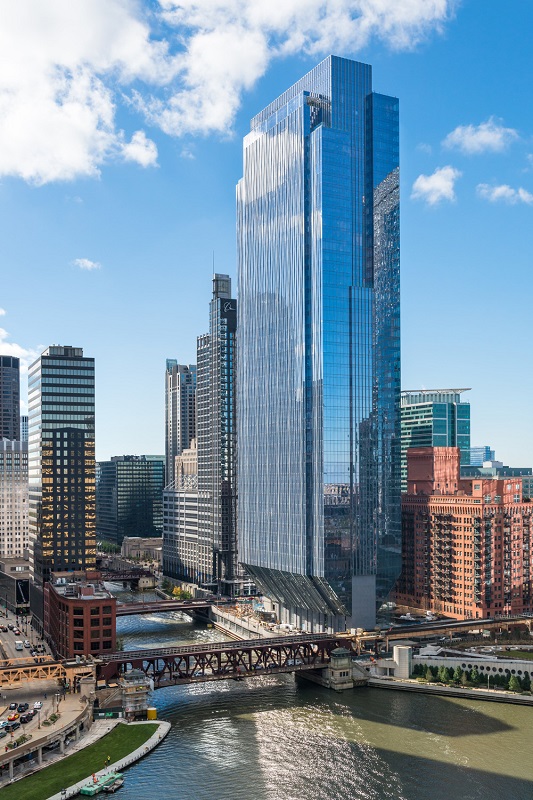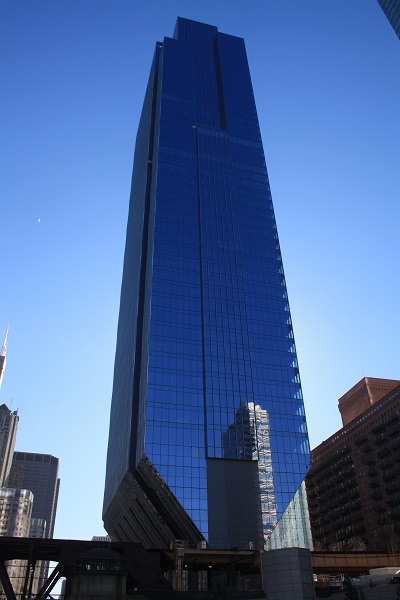150 North Riverside
In April 2017, a striking new commercial tower was completed in Chicago. 150 North Riverside is situated on a prominent waterfront site in the city’s West Loop.
The tower is remarkable for the way its 54-storeys are built on a base just 17 m wide, with the floors cantilevering out from the central core. It is also the first time Grade 70 steel has been used in the USA.
The design solution, by Goettsch Partners, was necessary as the tower is next to active train tracks to the west and the Chicago River to the east. The core-supported structure has a 20:1 height-to-base ratio, which allowed the incorporation of a public park with circulation routes, outdoor seating and an amphitheatre with views over the river. The tower’s first ‘full’ floor is on level 8, 30 m (100 ft) above the plaza.
Vertical mullions along the tower’s east and west facades create a pattern of light and shadow that changes throughout the day. The north and south facades are divided into three vertical planes, stepped forward and back to provide outdoor terraces and to accentuate the tower’s slenderness.
The tower was designed to achieve, and has been pre-certified as LEED Gold, with ample natural light and open spaces, and an extensive green roof. It has also been certified Wired Platinum for its telecommunications infrastructure.
At the ribbon-cutting ceremony, the Mayor of Chicago said:
“Today 150 North Riverside officially takes its place as the newest jewel in Chicago’s architectural landscape. But even more, this tower pushes Chicago’s architectural legacy into the 21st century by making an unmistakable addition to our skyline while building a new connection to our urban riverfront.”
[edit] Find out more
[edit] Related articles on Designing Buildings Wiki
Featured articles and news
Homes England supports Greencore Homes
42 new build affordable sustainable homes in Oxfordshire.
Zero carbon social housing: unlocking brownfield potential
Seven ZEDpod strategies for brownfield housing success.
CIOB report; a blueprint for SDGs and the built environment
Pairing the Sustainable Development Goals with projects.
Types, tests, standards and fires relating to external cladding
Brief descriptions with an extensive list of fires for review.
Latest Build UK Building Safety Regime explainer published
Key elements in one short, now updated document.
UKGBC launch the UK Climate Resilience Roadmap
First guidance of its kind on direct climate impacts for the built environment and how it can adapt.
CLC Health, Safety and Wellbeing Strategy 2025
Launched by the Minister for Industry to look at fatalities on site, improving mental health and other issues.
One of the most impressive Victorian architects. Book review.
Common Assessment Standard now with building safety
New CAS update now includes mandatory building safety questions.
RTPI leader to become new CIOB Chief Executive Officer
Dr Victoria Hills MRTPI, FICE to take over after Caroline Gumble’s departure.
Social and affordable housing, a long term plan for delivery
The “Delivering a Decade of Renewal for Social and Affordable Housing” strategy sets out future path.
A change to adoptive architecture
Effects of global weather warming on architectural detailing, material choice and human interaction.
The proposed publicly owned and backed subsidiary of Homes England, to facilitate new homes.
How big is the problem and what can we do to mitigate the effects?
Overheating guidance and tools for building designers
A number of cool guides to help with the heat.
The UK's Modern Industrial Strategy: A 10 year plan
Previous consultation criticism, current key elements and general support with some persisting reservations.
Building Safety Regulator reforms
New roles, new staff and a new fast track service pave the way for a single construction regulator.
























